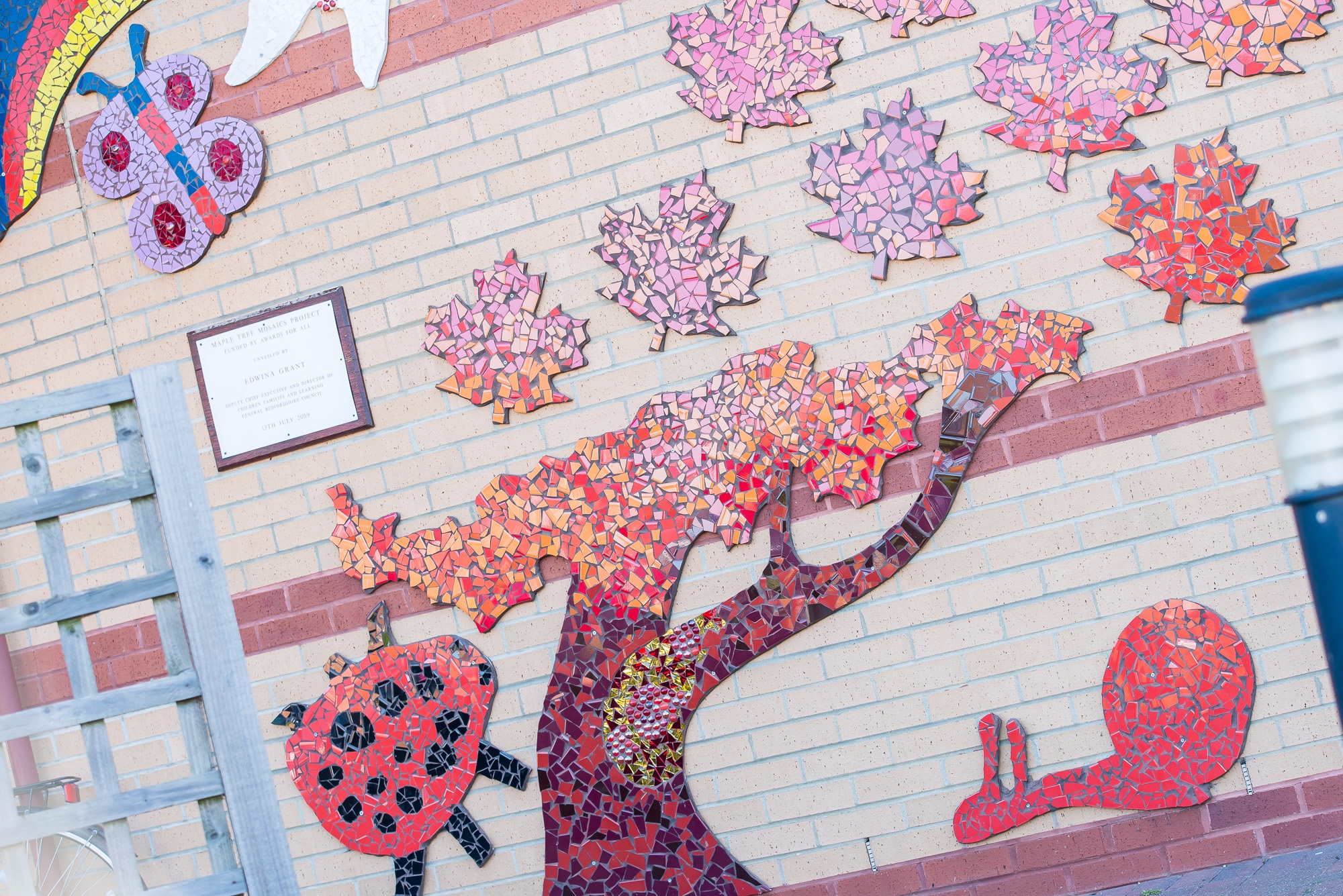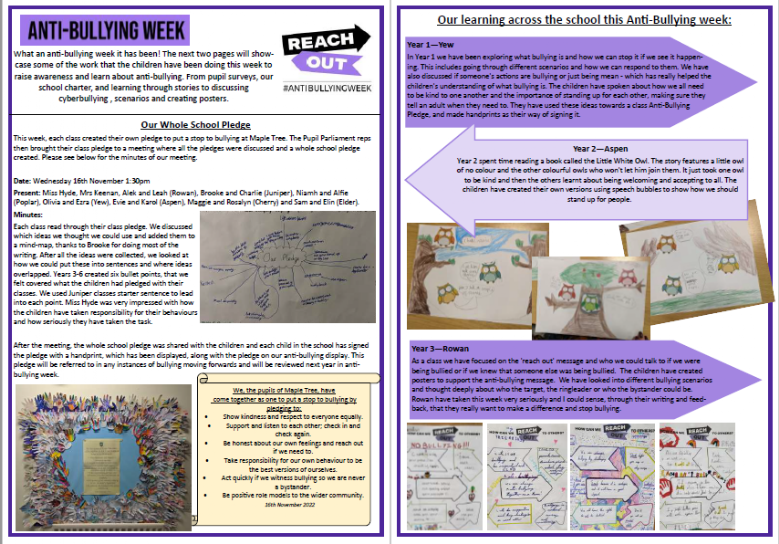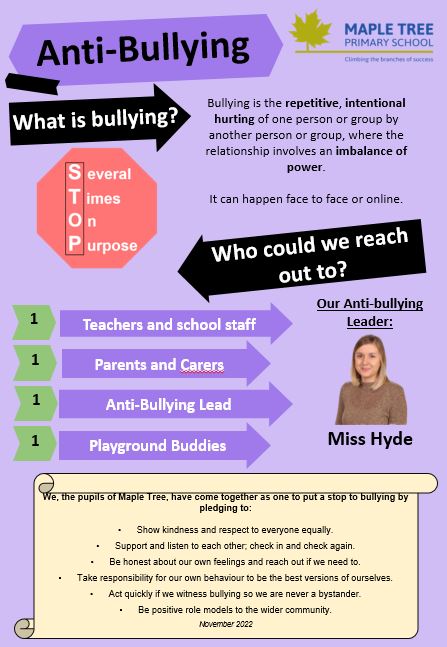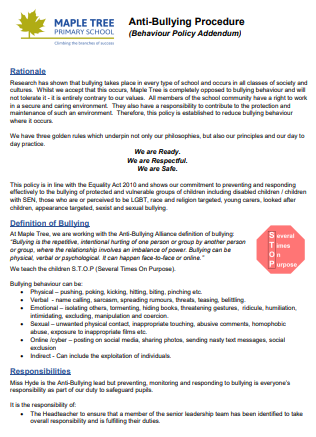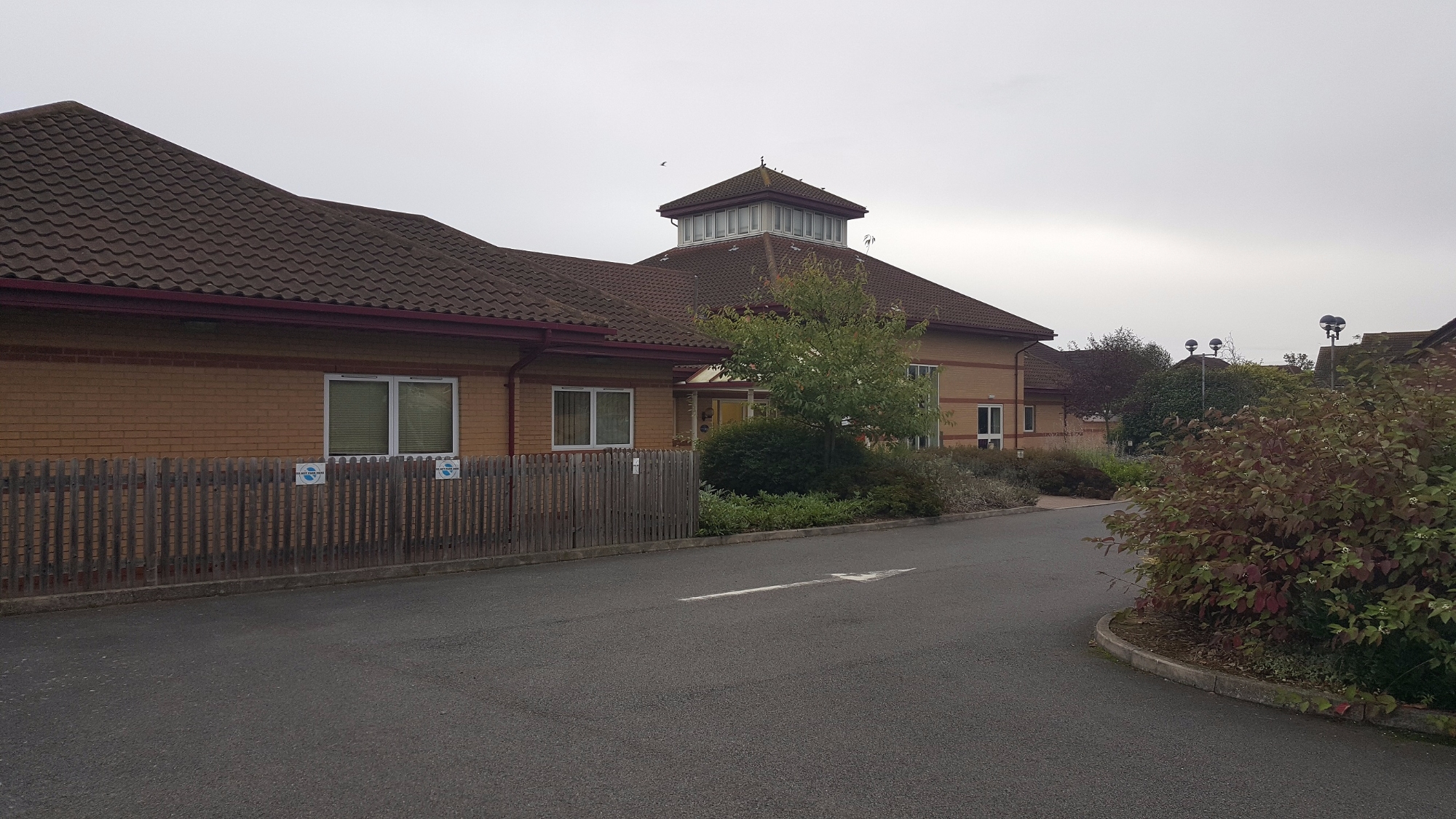Anti-Bullying
Maple Tree's definition of Bullying
Bullying is the repetitive, intentional hurting of one person or group by another person or group, where the relationship involves an imbalance of power (Anti-bullying Alliance agreed definition). It can happen face to face or online (cyber-bullying). This may include sexist, homophobic or racist comments. We teach the children S.T.O.P (Several Times On Purpose).
Forms of Bullying: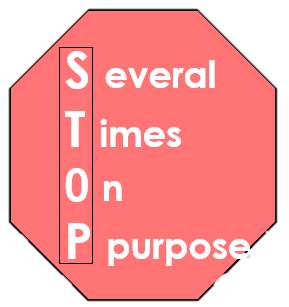
- Using offensive names when addressing another person
- Teasing or spreading rumours about another person or his/her family
- Belittling another person’s abilities and achievements
- Writing offensive notes or graffiti about another person
- Demands for money or possessions
- Interfering with, damaging, removing/stealing or hiding belongings of others.
- Excluding or isolating someone on purpose from a group or activity
- Physical violence such as hitting, pushing or spitting at another person
- Ridiculing another person’s appearance, way of speaking or personal mannerisms.
- Verbal abuse
- Misusing technology to hurt or humiliate another person
Procedures for dealing with incidents of bullying behaviour:
The named person for overseeing Bullying and Anti-Bullying is Miss Hyde, Deputy Head.
- Immediate intervention - set in motion agreed anti-bullying procedures.
- Steps taken to support and respond to the needs of both bullied and bullying pupils.
- Fill in the ‘Bullying and Prejudice’ incident form. Central records kept.
- Contacting parents/carers of all pupils concerned in the bullying incident.
- Investigation.
- Feedback to those concerned.
- Sanctions where appropriate. In serious cases may include exclusion.
- Contacting relevant professionals eg. School counsellor/Police

Anti-Bullying Alliance School Award Programme
We are excited to announce that we have signed up to the Anti-Bullying Alliance’s school award programme called ‘United Against Bullying’. It supports schools to reduce bullying and improve the wellbeing of all children, focusing on those most at risk.
As part of this programme, the school, led by Miss Hyde, are going to be reviewing our approach to Anti-bullying in the following areas:
- Anti-bullying policy - review our current policy and update with input from pupils, parents/carers and staff.
- Reporting and recording bullying - review how bullying is currently reported (how and to who) and how it is recorded and monitored by school leaders.
- Prevention and awareness—consider how the school teaches children about bullying in order to raise awareness and prevent it from happening.
- Acting on reports— explore how we support children experiencing bullying—both those being bullied or being the bully.
- Staff training—review how staff across school are trained in relation to anti-bullying by assessing their current subject knowledge.
- Focus on vulnerable groups—explore how the voices of all pupils are included and how we can best support our most vulnerable pupils.
What has happened so far?
Monday 14th November 2022 was the start of Anti-Bullying week. During this week we launched the theme for this year, which is ‘Reach Out’ through a whole school assembly. Monday 14th was also ‘odd socks’ day, where the children were encouraged to wear odd socks as an opportunity to encourage people to express themselves, celebrate their individuality and what makes us all unique!
During Anti-Bullying week, in class, children were taught about what bullying is and undertook lessons on how to combat bullying. Pupils undertook a survey, created a new whole school pledge and showed off their learning in an open afternoon to parents.
Click on the photo below to see more about how we marked Anti-Bullying week November 2022.
Staff Training:
In January, all school staff received training on what bullying is, what relational conflict is and importantly, what roles are involved in bullying incidents. In April, all classroom based staff received focussed training on how to prevent bullying and how to respond to bullying. In addition to this, Mrs Pond and Miss Hyde have both undertaken further training on how to support children showing bullying behaviours to make positive changes. As a parent, if you would like to learn more, free training is available from the Anti-Bullying Alliance.
Changes to procedure:
We are continually reviewing our processes and procedures in light of staff training and lessons learnt within school. Whenever a child receives a red card, this is logged and monitored by Miss Hyde to look for patterns in behaviour. This year, we have added a box asking ‘Does this incident flag bullying concerns?’ to ensure that staff are considering links between incidents and we are in the process of adding this to our first aid reporting forms too. We have also identified a named person, Miss Hyde, to speak to regarding any bullying concerns. We have recently created a dedicated 'reporting bullying form' for parents and carers too which you can access here.
Pupil Anti-Bullying Policy Workshop
On Thursday 27th April, Miss Hyde met with the pupil parliament representatives, who had spoken with their classes and were bringing back ideas on the following questions:
1. What is bullying?
Pupils like the acronym ‘STOP’ which means several times on purpose. They could give examples of what behaviours were bullying and what were not. Pupils in years 5 and 6 added that they understood about ‘power imbalances’ in relation to bullying e.g. groups vs individuals or older vs younger.
2. Where does bullying happen? Where can it happen?
Although pupils knew that bullying can happen anywhere, at school, home, out and about and online, the children identified that within school, it was most likely to happen at break and lunchtimes, in the school hall, playground or field. Years 5 and 6 feel that online bullying is a big concern for them, through their phones or games consoles.
3. What does school need to do about bullying?
Pupils knew that they wanted the teachers to get involved but weren’t sure what they could do. The representatives present all said that they would report bullying if they saw it. They said that they wanted to know more about what happened after bullying was reported.
4. How is the best way to report (tell someone) bullying?
Pupils knew that they could talk to any school adult about bullying and half the representatives knew that Miss Hyde was the named person for bullying. Some pupils said that they would rather tell their parents and let them speak to the school. Older pupils said that they would like a way to report bullying in writing, like a bullying postbox. Pupils suggested that a simple poster in each classroom with the ways to report bullying on might help pupils.
Actions following meeting: Create bullying postbox and posters for each classroom (see below and click the image to download.
Parents and Carers Survey
Thank you to the 32 parents and carers who completed the anti-bullying survey; we had a good spread of parents from mulberries up to year 6, with at least 4 people responding for each class.
· 72% of parents are confident that Maple Tree deals with bullying, with 25% somewhat confident and 3% not confident at all.
· 66% of parents state it is easy to report bullying with 31% choosing the middle ground or neither easy nor difficult and 3% saying not easy.
· Parents have shown that they would like varied methods for reporting bullying the school, including email, phone call, face-to-face meeting and dedicated reporting form.
Of those completing the survey, 25% of parents felt their child had been bullied in school in the last 12 months. Please note that this is 8 responses.
Where parents and carers state that bullying has occurred, they report that (they were able to choose more than one option for the following questions):
· 77% of this is verbal, 22% is physical, 22% is indirect and 0% online.
· 44% is appearance based with the rest choosing ‘reason unknown’. 0% feel is due to race, faith, gender, sexuality, or disability.
· 62% happens in a classroom, 62% on playground or field, 12% walking to or from school and 12% in the corridors.
· 89% of parents reported the bullying to school.
· 73% state that after they reported the bullying, the school took action and to stop the bullying and it stopped, 25% state that the school took action but it carried on and 12% state that the school took no action.
New procedure (within Behaviour Policy)
Following feedback from staff, pupils and parents and carers, a new anti-bullying procedure has been created as an addendum for the behaviour policy. Click the image below to download.
For further information on bullying and how to support your child you can look on the parents pages of the Anti - bullying alliance at www.anti-bullyingalliance.org.uk or from the CBBC website https://www.bbc.co.uk/cbbc/curations/anti-bullying-week

